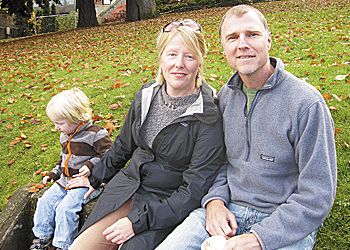Cultivating Complexity

By Stuart Watson
Over the course of several years, Scott Elder had poured enough wine into the soil of his soul to nurture a very green notion: He wanted to get into the wine business. But as he approached taking an assignment with Intel in Ireland, his pursuit of the passion “went quiet.”
Lucky for him, his then-girlfriend knew how much the wine idea meant to Elder. Rather than let it die, Stephanie LaMonica poured on the fertilizer. She bought Elder “The Wine Bible” by Karen MacNeil, and James Wilson's “Terroir: The Role of Geology, Climate, and Culture in the Making of French Wines.”
Two weeks before heading off to Ireland, Elder reached his own tipping point and turned down the road well traveled to a search for property, a vineyard, a label and the challenge of finding buyers for their first three releases under The Grande Dalles brand.
Like his well-traveled life, Elder's wines intentionally swim against the tide of American media and public favor. In a word, they strive for “complexity.” Elder weighs in frequently at his blog (www.theuncultivatedlife.com) on the position he hopes to achieve for his wines.
If “complexity” seems a bit ambiguous, wine lovers might default to the more familiar “Old World” or “food friendly” descriptors of wine and winemaking to appreciate what The Grande Dalles is attempting. Dialed-down fruit. More balanced acids and tannins.
To understand how Elder came to his deliberately contrarian approach to winemaking, it's good to move back the narrative to its roots: Total immersion in the world of French wines.
The child of Kansas wheat farmers, Elder came out of Northwest Missouri State University with a degree in chemistry. Good foundation. A doctorate in chemistry from Cornell piled on a brick or two, but it was the time outside his classroom, tasting the wines of the Finger Lakes region in upstate New York that got Elder's chemistry working. It also got him a small collection of Bordeaux.
“I wanted to do a post-doc, and my thesis adviser had a link to France, and I thought, if I go to France, I can learn more about wine,” Elder recalls.
A big part of that extracurricular study occurred in a small wine shop later voted “the best wine store in France.” After returning for more study at UC Berkeley, Elder pursued his love of wine up the road to Napa Valley. And after he got his first job at the Pacific Northwest National Laboratory in Richland, Wash., he found himself living on Red Mountain.
Ker-plunk. Five years there taught him a lot about the style of wine favored by many Northwest producers. Big, ripe, jammy. Lots and lots of lots.
After joining Intel in Beaverton, he and LaMonica met, survived the Ireland phase — separated for months while she waited out her pet cat’s quarantine — and married in 2004. They honeymooned in … Roseburg. It seemed a good idea, because Elder was busy researching dirt.
“Limestone is the key to many of the best French wines,” he says. “I needed neutral, slightly alkaline soil. But there are few limestone soils in Oregon.”
The quest led them next to the Columbia Plateau, dry land with ideal pH. In August 2005, they bought 160 acres from farmer Jack Hay, after spending $20,000 on a test well that hit water at 180 feet. With help from Roseburg-area vineyard owner Leroy Rasmussen, they laid out a 34-acre vineyard. Of that, 15 acres are now producing.
As happens with farming, weather threw them a quick curve. A hard freeze the first winter cost them 25 percent of their plants. “It was a huge blow to our morale,” Elder says.
After approaching buyers with their first (2008) harvest, they met a skeptical response. What to do with a bunch of unsold grapes? Buy barrels, find a facility, make wine. Tim Schechtel of Erin Glenn Winery produced the 2008 release — Leroy’s Finest (Riesling; $30 retail), Gampo (Sangiovese, Cabernet Sauvignon and Cabernet Franc; $60), and Home Place (Tempranillo, Cabernet Sauvignon and Cabernet Franc; $60). The first release filled 250 cases.
The Grande Dalles has since moved its winemaking to Pheasant Valley Vineyard & Winery near Hood River. Elder estimates the 2009 and 2010 vintages will produce 600-plus cases. Wines are available through the website.
Elder says he has gotten positive appraisal from Portland-area restaurant wine buyers, but a reluctance to add his wines to lists aimed at Northwest palates. That didn’t come as a complete surprise. “We thought they would appeal more to an East Coast palate,” he says. A wine market, in other words, looking across the pond at Europe.
“The biggest decision with wine is when to harvest,” he says. “I want the grape to create structured wines. I want the tannins and acidity to evolve in a positive direction over time. The people who know say that will happen with our wines.”
LaMonica, with a Master’s in Applied Linguistics and a work history in branding, communications and grant writing, supports the enterprise — and their son, Samuel — in the virtual realm, managing the website and online marketing. Through those vehicles, someone curious about this new venture will find a refreshing level of candor and transparency. As attested to in the headline on one of Elder’s recent blog posts, “Will we sell our first vintage?,” these are two people unafraid to share the lows — and highs — of a risky leap into the wine world — even as they cling tenaciously to their vision.
“We don’t make our wine to please the broadest possible tastes,” Elder says. “We do it the way we like it. Some will like it. Some won’t.”
A veteran Northwest newspaper and magazine reporter and editor, Stu Watson owns Watsonx2 Communications in Hood River.












